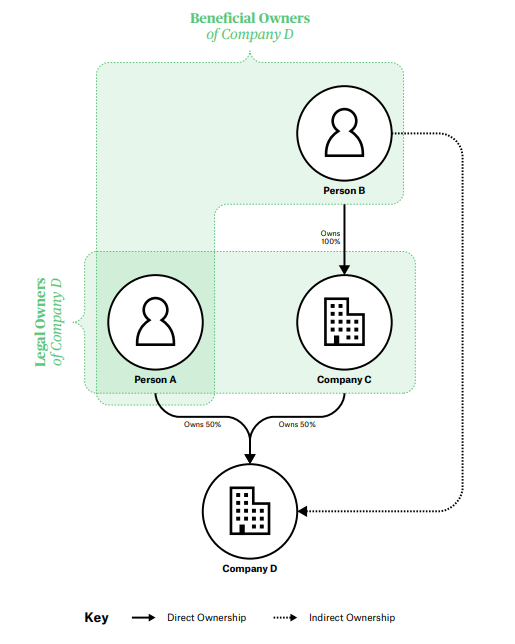Beneficial ownership data in procurement
Public procurement and contracting
As a significant amount of taxpayer money is spent on public procurement, governments owe it to their citizens to procure efficiently, to ensure a high quality of service delivery, and to safeguard public interests. Most procurement is regulated by both international and national legal frameworks and guided by processes that ensure fair, equitable, transparent, competitive, and cost-effective buying. This typically involves the requirement to issue public tenders for contracts whose value exceeds a certain threshold, for which private companies compete. A contract awardee is subsequently selected along objective criteria.
Figure 2. The five stages in a contracting process

Government contracting can be summarised in five stages. Note that not all contracting processes go through all stages. Direct contracting, for example, will not have a tender stage. Source: Adapted from the Open Contracting Partnership (standard.open-contracting.org/latest/en/getting_started/contracting_process).
Besides ensuring a fair, competitive process for efficient service delivery and value-for-money for taxpayers, procurement can also realise a number of additional, or horizontal policy objectives, referred to as strategic public procurement. [7] In these cases, certain suppliers are preferred over others to help meet specific objectives (also referred to as preferential procurement), and certain characteristics of private enterprises are factored into the selection criteria. Whilst needing to be balanced against other procurement objectives, horizontal policy aims can include stimulating innovation or help certain environmental or social policy objectives. In some other cases, traditional procurement principles may also be disregarded. For instance, in defence procurement, domestic and trusted suppliers are often preferred for national security reasons.
Evidence has shown that transparency in contracting data around the contracting stages improves procurement processes. For instance, publishing more information about procurements reduces single-bid tenders. Single-bid tenders are more expensive for governments, reduce competition, and present governance risks. [8] In addition to decreasing costs and improving competition, and therefore service delivery, a World Bank study has shown that contracting transparency also decreases corruption risks and kickbacks. [9] Open procurement data allows both government and civil society to conduct analysis on procurement. Linking procurement data to other relevant datasets, such as spending data or BO data, allows for a more comprehensive understanding of how public procurement is conducted. This provides a better and more objective basis upon which policy decisions can be made. [10] As a result, many governments have committed to publishing open contracting data. [A]
Beneficial ownership
The owner of a company frequently refers to the direct legal owner of a company. However, companies are able to own companies, and complex ownership structures are relatively common. The concept of BO is useful in order to understand who actually owns and controls companies, and therefore who you are really doing business with. A beneficial owner is the natural person who ultimately owns or controls a legal entity, either directly or indirectly. [B]
Figure 3. Types of ownership

Person A and Company C are the legal owners of Company D. Person B is the legal owner of Company C. Person A and Person B are the beneficial owners of Company D. Person A exercises his/her ownership directly, while Person B exercises his/her ownership indirectly through Company C. Company C cannot be a beneficial owner as it is not a natural person.
BO is a particularly helpful concept in anti-corruption and AML, as companies can be used to disguise a company’s true ownership (for instance, through setting up parent shell companies in secrecy jurisdictions). These companies can subsequently open bank accounts, granting them access to the global financial system whilst keeping links to the people who really benefit – the beneficial owners – hidden. According to a World Bank study, 70% of all grand corruption cases involve the use of anonymously owned companies. [11]
BO data can be collected by governments specifically for procurement, or as disclosures for an entire economy in central registers in order to fulfil a range of additional policy aims. In both cases, this data may be published and made publicly accessible (for instance, to facilitate external verification of the data). [12] In certain cases, companies may not have a beneficial owner that meets the declaration requirements according to the legal definition in a jurisdiction. Even in these cases, detailed and high quality BO disclosures, together with other disclosures, can still provide helpful insights into management and ownership structures, which can, for instance, provide useful insights into risks associated with subsidiaries.
Footnotes
[7] “Reforming Public Procurement: Progress in Implementing the 2015 OECD Recommendation”, Organisation for Economic Co-operation and Development (OECD), 2019, https://www.oecd-ilibrary.org/sites/717274af-en/index.html?itemId=/content/component/717274af-en.
[8] Monika Bauhr, Agnes Czibik, Mihaly Fazekas, and Jenny de Fine Licht, “D3.2 Lights on the Shadows of Public Procurement. Transparency in government contracting as an antidote to corruption?”, DIGIWHIST, 31 August 2017, http://digiwhist.eu/publications/lights-on-the-shadows-of-publicprocurement-transparency-in-government-contracting-as-an-antidote-tocorruption/.
[9] Stephen Knack, Nataliya Biletska, and Kanishka Kacker, “Deterring Kickbacks and Encouraging Entry in Public Procurement Markets: Evidence from Firm Surveys in 88 Developing Countries”, World Bank, May 2017, https://openknowledge.worldbank.org/handle/10986/26950.
[10] Mihály Fazekas and Elizabeth Dávid-Barrett, “Corruption Risks in UK Public Procurement and New AntiCorruption Tools”, Government Transparency Institute, November 2015, 2, http://www.govtransparency.eu/wp-content/uploads/2016/10/Fazekas-David-Barrett_Public-procurement-review_public_151113.pdf.
[A] For more information about open contracting see the Open Contracting Partnership (OCP), which has developed the Open Contracting Data Standard (OCDS) for this purpose. “Open contracting delivers and why it’s the smart thing to do”, OCP, n.d., https://www.open-contracting.org/impact/.
[B] For more information on defining BO and the legal aspects associated with this, please see: Peter Low and Tymon Kiepe, “Beneficial ownership in law: Definitions and thresholds”, Open Ownership, October 2020, https://www.openownership.org/uploads/definitions-briefing.pdf.
[11] Emile van der Does de Willebois, Emily M. Halter, Robert A. Harrison, Ji Won Park, and J.C. Sharman, “The Puppet Masters: How the Corrupt Use Legal Structures to Hide Stolen Assets and What to Do About It”, StAR (Stolen Asset Recovery Initiative), World Bank, and United Nations Office on Drugs and Crime (UNODC), 2011, 2, https://star.worldbank.org/sites/star/files/puppetmastersv1.pdf.
[12] Tymon Kiepe, “Verification of Beneficial Ownership Data”, Open Ownership, May 2020, 7, https://www.openownership.org/uploads/OpenOwnership%20Verification%20Briefing.pdf.
Next page: Use cases of beneficial ownership transparency in public procurement